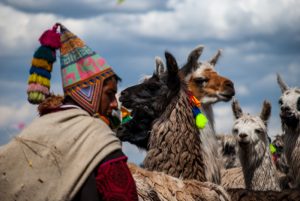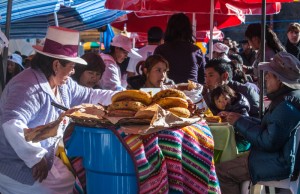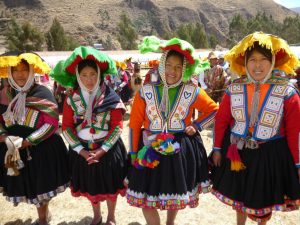Eating and Sharing Make the Cosmos Work

Surrounding the city of Cuzco rural communities farm the land and herd the flocks of sheep, alpacas, and llamas for which the department of Cuzco is famous. These vast expanses of land with scattered farmsteads hold people who almost entirely speak Quechua. Many anthropologists and folklorists have gone to live among them in search for ideas, rituals, and even agricultural techniques that might remit to Inca times.
Ethnographer Inge Bolin wrote a book about the potato farming and llama herding community Chillihuani far up in the Cuzco mountains. Entitled Rituals of Respect, the Secret of Survival in the High Andes, the work begins by narrating family rituals at a time of fear when lightning falls all around as a means of showing the power of a dramatic landscape. Bolin claims the landscape and peoples ideas of it fills the ritual life of the people of Chilinhuani.

In their rituals Bolin finds the key to their surviving in their high mountain environment over centuries. Indeed, many of the rituals of the people of Chillihuani suggest a continuity from Inca times, according to this analysis.
When Chillihuani’s people come together for ritual they feed each other, themselves, and the world around them. Sharing food or drink are basic to their life and indeed may constitute the basis of how they manage to continue in such a difficult environment.
Beginning with the lead up to Puqllay, a Quechua word meaning play which in this context translates the Spanish Carnival, Bolin discusses the rituals of family, reproduction of the herds, courtship and community as she moves through a few short months of the people’s annual round.


At each step she describes the foods people eat. For example, on page 144 she tells of a meal consumed during the ritual of marriage. During the meal people perform, what Bolin calls rituals of respect. They offer their plate to every other person present “who receives it with gratitude, pretends to take a taste, and returns it to the person who offered it.” As we have noted in this blog, in contemporary Cuzco people often taste each others food when in a restaurant where they have ordered different dishes; they do not simply pretend to do so.
The people of Chillihuani are eating a cold meal which Bolin describes as consisting of “potatoes, corn tortillas [probably a fritter, called a torreja instead of a Mexican-style tortilla], rice, beans [something very difficult to prepare at high altitude, ch’arki [dried meat], qochayuyu [lake-weed or seaweed], and roasted corn [probably canchitas].”
The food is distributed by a man to everyone present. The server “carefully wipes the bottom of the plate before handing it to someone.”
After the cold food is consumed, young men bring hot soup to the bridal group and all the guests in the compound. Everyone enjoys the delicious hot soup, a blessing on a cold winter night. Bride and groom use only one plate and one spoon, sharing the precious food. The soup is yawal chhallcha, consisting of boiled blood, onions, salt, garlic, and spices. In the belief that what happes during the wedding festivity will determine the future life of the newlyweds, everyone eats and drinks much during these days of lavish generosity.

This is but one example of Bolin’s attention to detail and her emphasis on how food, and other ritual, brings people together with each other and with the landscape that to them is alive. Sharing food and eating is basic in their cosmology and, as a consequence, receives great attention in the life of Chillihuani, and most other communities around Cuzco, as well as in the city itself.




